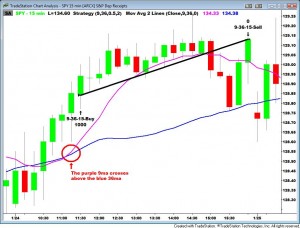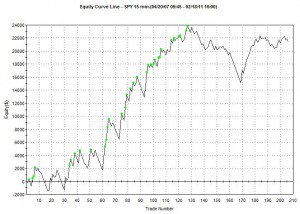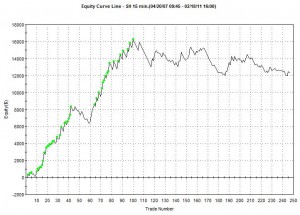The “9-36-15 Cross” technique gives a buy signal when the 9-period moving-average crosses above the 36 average on the 15-minute chart. I coded a TradeStation strategy to implement it for SPY with the following day-trading rules:
1) Only enter trades before 1pm
2) After a cross, go long with a market order
3) Take profits if SPY advances $2.00 per share
4) Or close the trade after 3:55pm
5) Stop-Loss = $0.50 per share
Here is a sample trade from January 24, 2011 (click chart to enlarge):
The cross-up occurred on the 11:15am bar (red circle) and the strategy opened the trade on the next bar. SPY didn’t hit our $2 target, so the trade was closed before the bell with a small profit (follow the black line).
Between April 20, 2007 and February 18, 2011 (a 1,000 day period) the strategy generated 206 trades and a 21.37% return. The equity curve using 1,000 shares of SPY shows a cumulative profit of $21,368.12:
Now let’s see how well it does with the inverse ETF, SH, which is SPY’s evil twin. Since SH has a lower price, we use a $1.00 profit target and a $0.25 stop-loss:
Not too shabby, right? Amazingly, using this mechanical technique, you could have made money during this period by being a bull or a bear.
The 1pm deadline is just to prevent the strategy from putting a trade on late in the day when you are just going to be closing it soon anyway. A computer needs such an arbitrary time. In practice, making your trades by hand, you can let it slide, of course.
When doing these tests, I just set the stop-loss amounts and profit-targets to what seemed reasonable. Other settings might be much better. I could run the strategy through the optimizer and produce much more impressive results, but I don’t recommend that. It’s best to think of an optimizer as more of a hypnotizer. Stock charts are like snow flakes. That beautiful snow flake that you found with your back-testing will never occur again, so there is no point in looking for it.
Both examples above use a $7.95 commission per trade.
You can look over the stats with the spreadsheets that TradeStation spits out:
If you like this trading strategy, then you are going to love my book: The General Theory of Day-Trading.


